originally posted at https://canmom.tumblr.com/post/795218...
it’s been a while since i’ve done this sort of ‘associative ramble’ post on here…
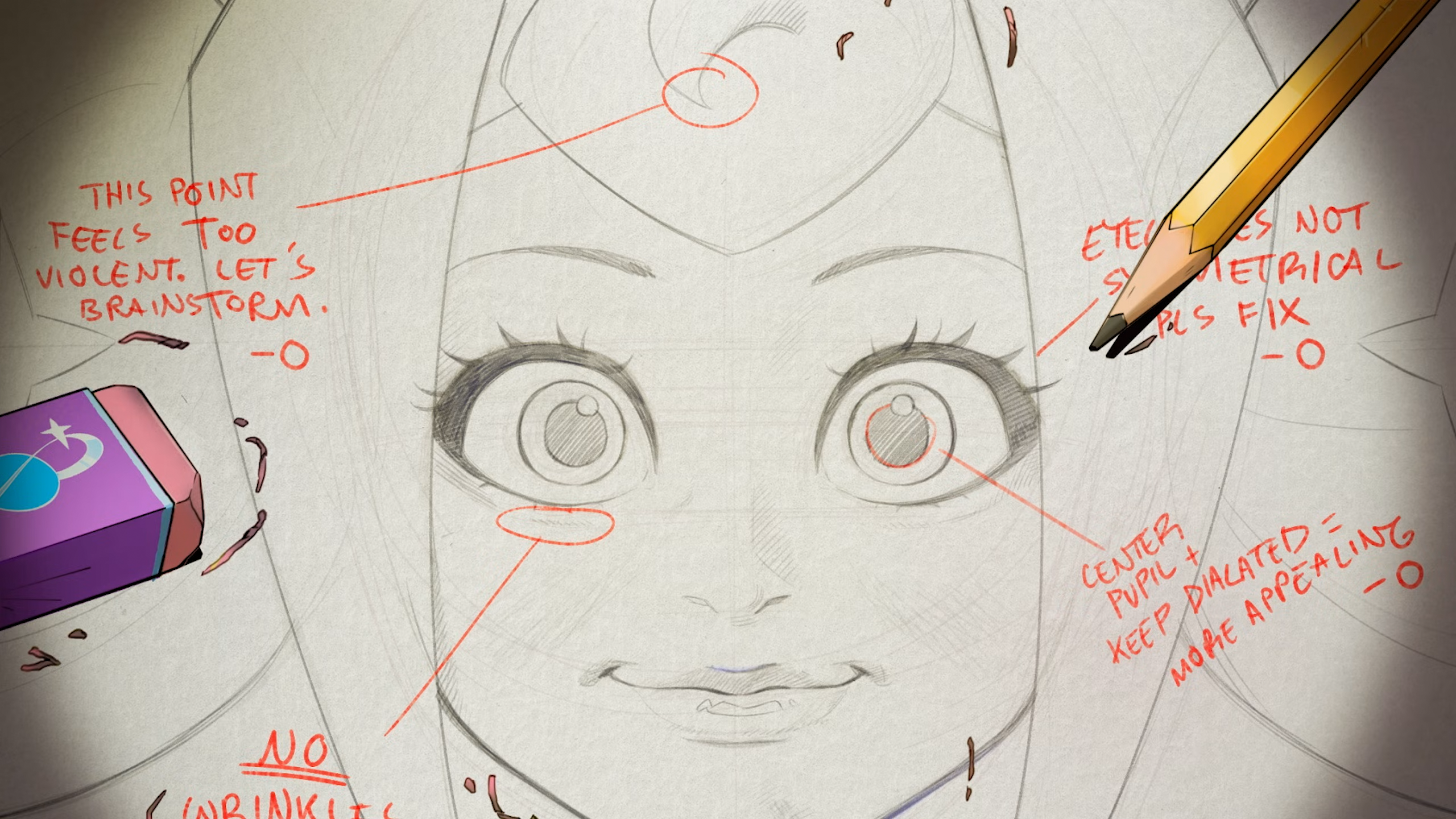
this very brief shot is for me the most interesting one for me in the Knights of Guinevere pilot. because the show is about this kind of tortured feminised symbol character right, this constructed appealmaxxing entity that is used as the face of the park. and these are the kind of design iteration notes that would be pretty typical in developing an animated show. (I don’t think they’re necessarily the real ones from this show! but similar design decisions would be made.) every single element of the character design is subject to this optimisation process.
and you know, for me it’s natural to link that to director Dana Terrace previously being known for making The Owl House at Disney, and how much I imagine it must have sucked to work for Disney. well, hooray, she’s making weirder shit at a small web animation studio, good end.
and yet… the whole thing can’t help but draw attention to what an animation studio is.
there’s some (likely somewhat intentional) irony in the credits showing a little reel of plushies and such you can buy to “support the show”:
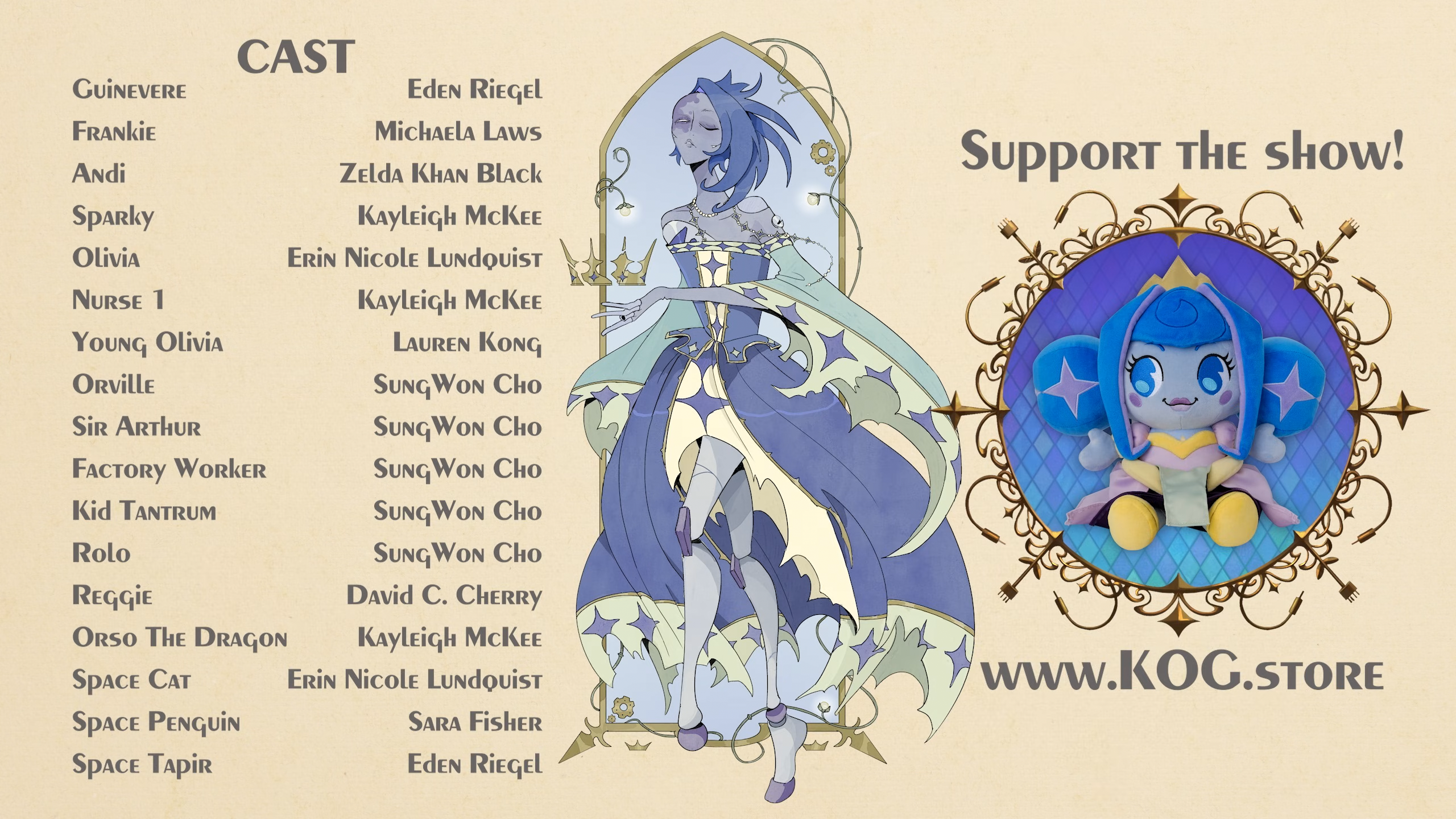
because of course the whole setting and themes of the show are covering familiar themes about like, factories making exactly this sort of thing, cascades of waste getting inefficiently recycled. so it sort of really calls your attention to something like the metabolism of an animated show like this, considered as an organism (an egregore).
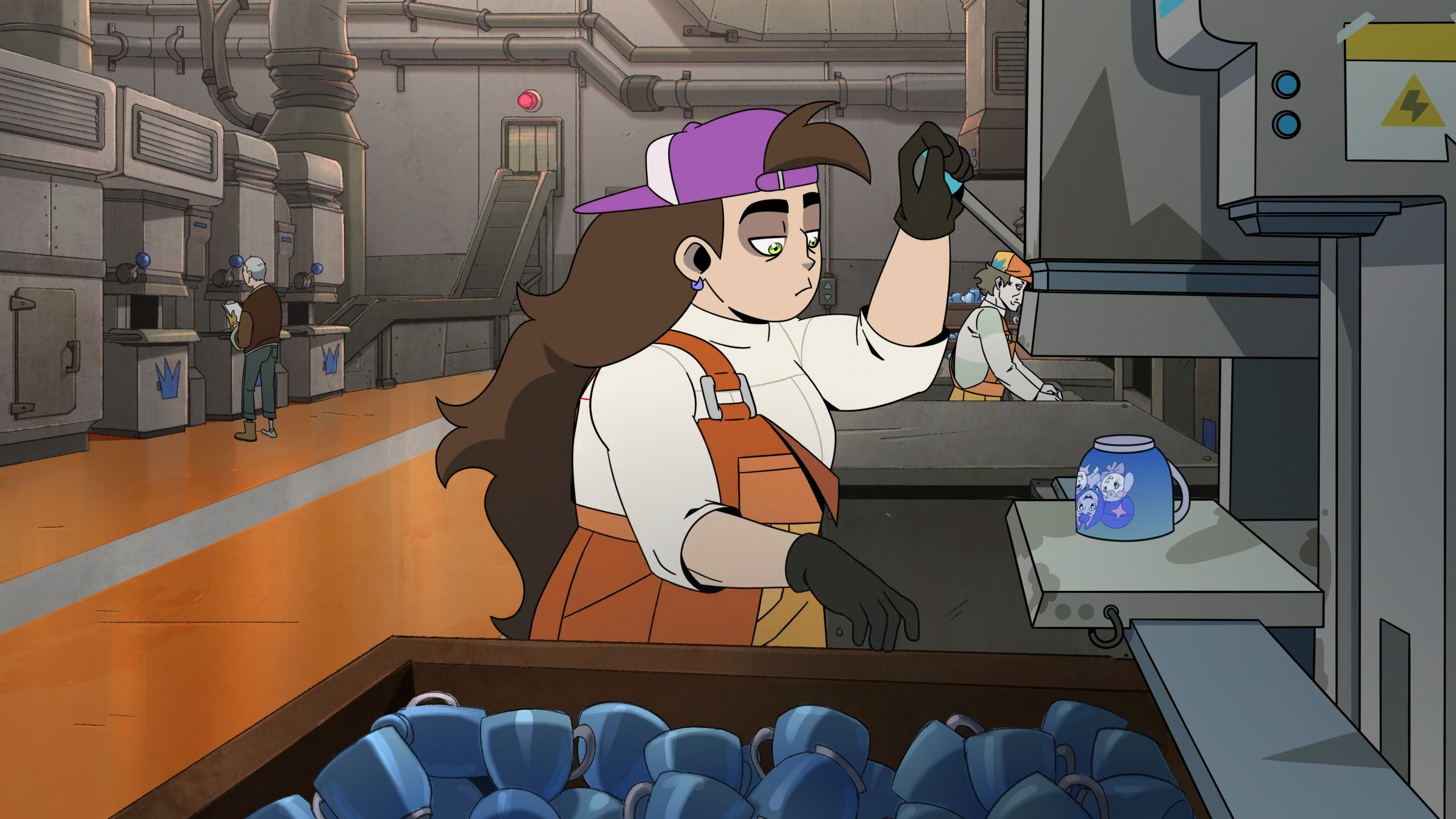
from a miserably alien socioeconomic perspective, the creative workers at Glitch do their best to create an appealing, emotionally engaging narrative. in the minds of the viewers, this creates a complex of connected images and symbols such that a fraction of them will be motivated to do something they wouldn’t otherwise - for example, buy what would in another light be a stitched fabric bag containing soft foam, basically a weirdly shaped pillow, because it looks similar to the design of the animated character and associatively brings to mind those positive feelings.1
so this thing I’m discussing is a model of information-replicator that proves evolutionary adaptive on the substrate of connected human brains and machines in a capitalist economy. that’s a lot of words, lemme elaborate.
to finish the story above, the show motivates sale of merch, and the merch makes a number on a computer somewhere go up representing “the amount of money in Glitch’s bank account”. Glitch, in turn, reduces that number to increase the numbers associated with its employees, which allows them to access a portion of the social product like food and flats to live in and plushies and so on. thus the employees are strongly motivated to keep making stuff for Glitch, completing the cycle.
every part of the system is coupled to other parts of the system and has mechanisms to maintain the equilibrium where this ‘program’ can execute. it would not exist if that weren’t so.
for example, should Glitch try to pay its employees without a large enough number in its bank account, it would trigger responses at the bank and in the wider society that would potentially lead to “Glitch”’s access to the system, and ultimately its ability to operate as a coherent entity, being denied. (which in practical terms might lead to humans being assigned to show up at the Glitch offices to threaten the owners with violence and so on.) and of course there are copyright mechanisms and the like which mark the boundaries of what counts as being part of “Glitch”.2
Glitch Productions is not a fundamentally different entity than the Mouse. they have a different repertoire of symbols - they like their existentialist themes, dystopian settings, stylised gore but not anything you can’t show on youtube, etc. - and less all-consuming reach, it sounds like a much better place to work, but the logic of its replication differs mostly just in terms of scale. beyond the walls of the studio, many hands are making those plushies and figurines and operating the infrastructure that distributes the video data.
what is sorta interesting about Glitch to me is that some of their projects seem designed to play on that subject in a meta way - but also they’re kinda having their cake and eating it!
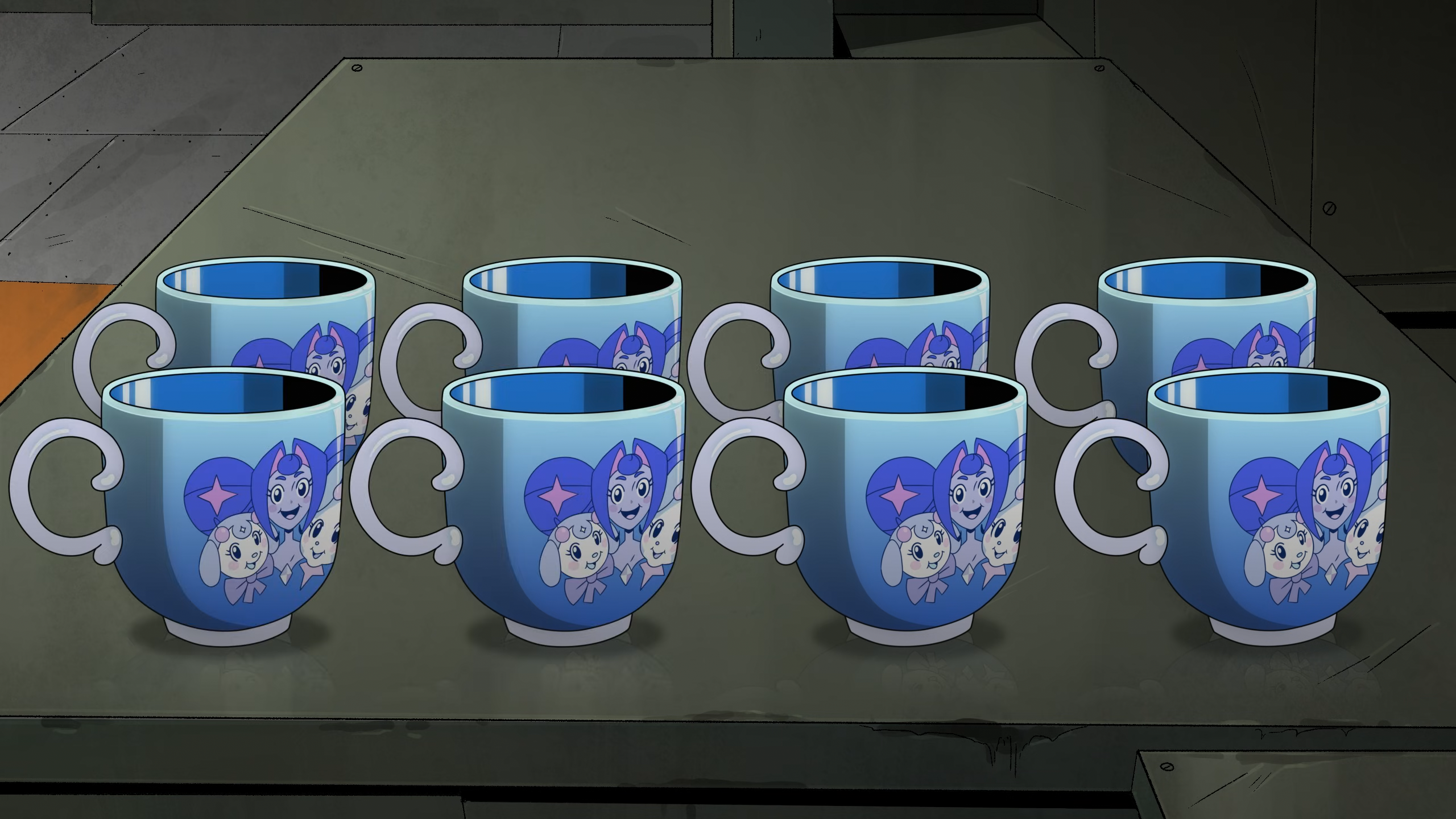
so, the characters in Digital Circus struggle with the existential angst of existing only as narrowly defined entertainment archetypes stuck in an eternal void of ephemeral, meaningless activities. the characters in Guinevere all live in relation to a world-spanning theme park which represents itself through animatronic characters and endless branded merchandise, with a focus being the work of maintaining that system (the princess keeps getting mechabare’d trying to escape and repaired by her owner; the other two protagonists are both repair and salvage workers).
and i mean, these sorta themes are not new. humanity collectively really got into this sort of thing around the mid 20th century - particularly in like, literature, theatre and “arthouse” film. (you know, modernism.)
what is kind of funny is doing all this existential absurdist whatever about the structure of entertainment media and its costs… as widely appealing mass media with a line of merch, and doing so very successfully from the looks of things! western animation (outside of the european film fund system perhaps) is kind of in crisis mode, but glitch’s model seems to be working pretty well for them at the moment.
now, as far as a business model is concerned, it doesn’t really matter what the content being distributed is, as long as it motivates people to buy shit. there’s no irony to the capitalist in profiting off existentialism or a critique of the capitalist system. but as far as artists in these industries are concerned, the actual substance of that content is everything! and the merch line is just a mechanism to allow us to stay alive and keep making things we like to make.
still… zoom out and we can tell a similar story about the broader system that produces us artists. we are born, our brains are initialised to a random state, and we grow up and interact with our environment and that brain learns to be something, or rather, many somethings…
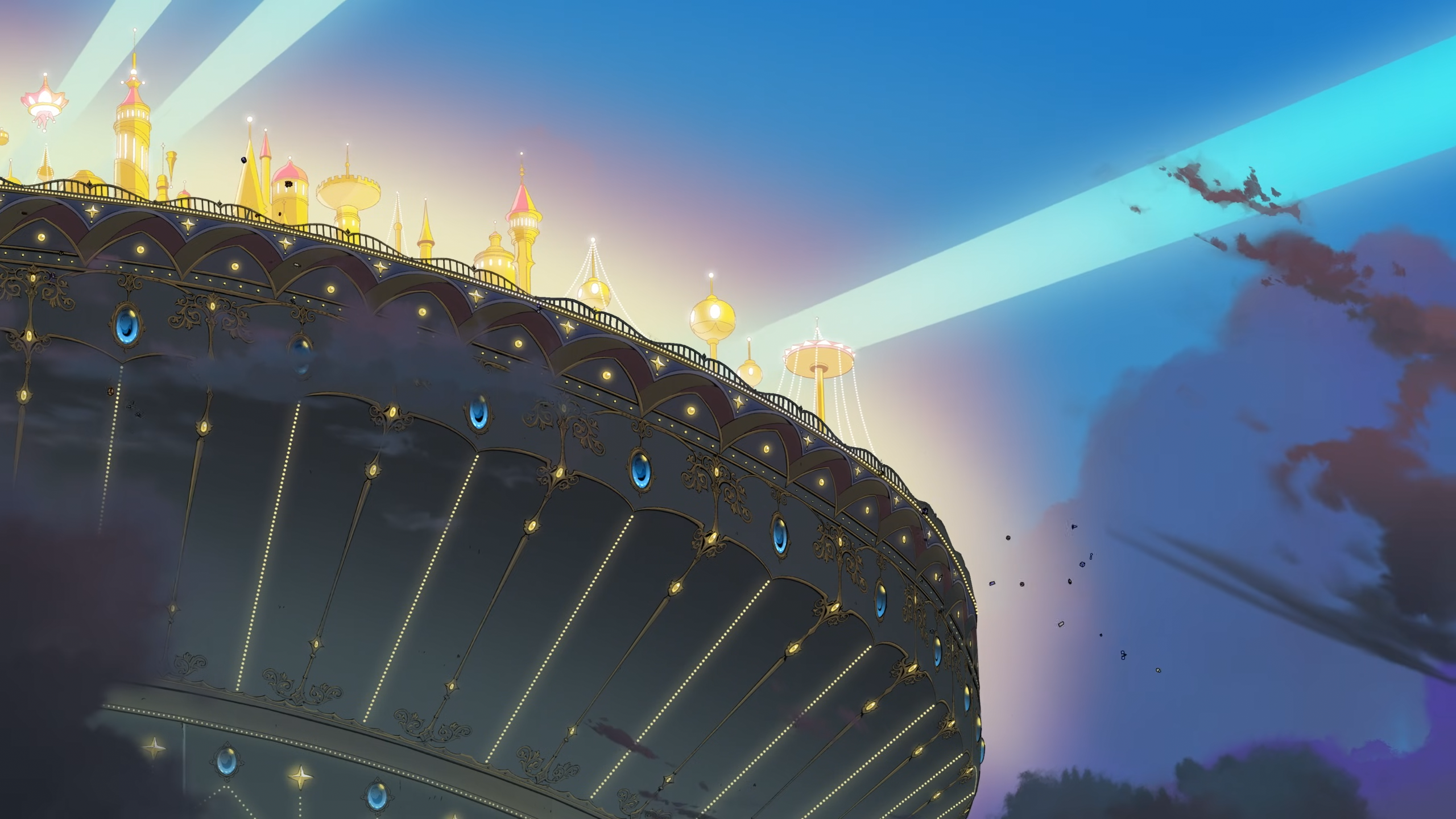
in that process we’re introduced to these narrative-things - films, games, books, etc. - how to interpret them, how they fit into the broader environment, etc. and some of us think “that’s cool shit” and become motivated to become the sort of person who makes that. one way or another, over the ensuing decades we make it through the gauntlet and (formally or informally) learn the tricks of that trade, i.e. internalise the narratives of what the medium is and what actions are available that count as ‘making art in that medium’.
rotate our view a bit: we can view the self-narrative structure ‘being a person who is making animated films’ (for example) as something like a computer program. it’s not precisely specified though - lots of variations - but nevertheless, when it runs, it gets you to perform certain rather abstruse actions, like put paint on paper and show it to people, or coherently participate in a studio making an animated cartoon.
the process I’m describing is how that program of ‘being an animator’ replicates itself. animators make animation, and animation in turn generates animators, by making humans (who might otherwise do anything else) operate in the role of animators. replicator loop.
and yeah, marx talked about this kind of thing: the dual circuits of reproduction of capital and labour. but I guess what I’m trying to do here is take on an angle that focuses more on the propagation of information than like, the nebulous quantity of ‘value’.
like, I’m trying to consider this all from the light you do when you observe structures in a cellular automaton. we recognise a glider gun producing gliders, but throw in a few cells in the wrong place and the self-replicating pattern will break down and explode into a random-looking mess of oscillators. a more robust system, like the trained-in state in a neural cellular automata, would recover itself from perturbation.
…this is not where I thought this post was going when I sat down to write, but hey, lets go with it.
the normal view of individual humans is that we all have a unique nature, an ‘inner law’ particular to each of us - call it a soul or whatever. I don’t think this is wrong exactly, but it’s more like one lens on the ‘collection of humans’ information-system.
from another view, the thoughts in my brain are extensions of information that I received from other people in my society, developed an internal representation of them, iterated the thought forward a bit, and then I potentially send the results back out in a serialised, encoded form (you are reading such a thing right now). the specific combination of elements (memories, beliefs, ideas, patterns of thinking) that my brain has learned to represent may be unique, but the computation of thoughts is happening in a distributed way, rippling across the whole society in waves, carried along by replicators like the ones discussed above.
now, one of the neat things about Glitch, in keeping with the character they are playing of ‘young, indie distributed animation studio on a social video platform’, is that they are keen for their animators to post production materials and discuss the process. for example, here’s Genus:
suppose we try to work out what is the ‘mind’ that makes an artefact like “an episode of Digital Circus”? by mind I mean something like a process that expresses some sort of agency, potentially encompassing many human minds, but not necessarily “something with a subjective experience” in its own right. perhaps we have a hypothesis, like the auteur theory that we should mainly consider Gooseworx, the show’s director.
so, let’s say Genus animates a shot, making a variety of specific creative decisions on how to time the motions, tweak the rig to make a funny face etc. he’s doing his best to guess what Gooseworx wants, expressed both through her storyboard and his internal sense of what the project is about, who the characters are, etc. (Gooseworx herself is not directly making those creative decisions at this point, but Genus’s model of Gooseworx is part of his process… is that enough to count?)
he finishes a pass, and Goose or Austan or someone else looks at it, makes a judgement of it - now with a concrete thing in front of them to work from - weighs it against the narrative intent, and decides on whether and how it should be adjusted, or maybe Genus came up with a better idea in the moment and they go with that. Genus interprets that instruction and makes it concrete. once everyone’s happy, it goes through a similar loop during comp, render etc.
on the other side, Goose is weighing up her own set of considerations - what she “wants to express” of course, but that has to be modulo [what Youtube allows on their platform, the general mood in the team she’s working with, whether she can communicate the idea to her team, what will keep her job or allow her to make more shows in the future, how fans are reacting on social media, thoughts and feelings inspired by the actual concrete episodes that have been produced so far… these are all inputs. also inputs are the experiences that made her get into animation in the first place, works that inspired her, what she learned about animation from making shorts like Elain the Bounty Hunter and Little Runmo…] and for all of that, the same goes for everyone else on the team. her process involves (at least) drawing ideas on a storyboard, considering them, perhaps scrapping and redrawing them…
on top of that we can add all sorts of other context - what people eat (the literal metabolism), what’s in the news - to the point that we reach pretty much all of society is sorta implicated in this process.
well, that’s no good. at some point we need to draw a boundary and say this part is ‘outside’ and this part is ‘inside’ the process we’re interested in.
how do we do we build these sorts of stories? we use our ability to recognise patterns, and make an intuitive decision - a guess we can revise if it doesn’t work! - as to what are the important elements. and then we can look at how information flows between these different elements, and what makes those elements exist in a stable way.
for example, the entities I considered here, in this version of the story, are characters like (my model of) Gooseworx and (my model of) Genus. these humans-in-the-role-of-animation-workers are clusters in the broader system, places where information pools and cross-pollinates. since you can’t really clone the state of brains, the skull is a fairly sensible place to put a boundary between ‘entities’, but a different version of the story might draw our attention somewhere else.
we can zoom in tighter than the level of an individual human, for example, of all that vast amount of potentially relevant information, how does an individual human brain select what to factor in?
well, we have some idea how brains load memories associatively from regions like the neocortex. Gooseworx’s brain has a lot to do besides directing an animated show, in all the other parts of her life. …talking about Gooseworx specifically is getting kind of weird at this point so I’ll use myself as another example. when I sit down at my computer and open Blender or a code editor, these actions act as keys in the key-value store to bring up the memories associated with ‘being an animator’, ‘being a game developer’ or ‘being a demoscener’ and allow me to step into that role and think really hard about, say, readable key poses, mutex locks and render pipelines.
likewise, when I sit down to write a Tumblr post like this, or lie in bed thinking about the human condition or whatever, my brain will load a different set of thinking patterns and connections to draw. the boundaries between these roles are kind of nebulous and there is a lot of cross-pollination - the fact I’ve been focusing on programming and computation lately, and the impact of digesting all that neuroscience and philosophy of mind stuff earlier this year, means that subjects like ‘computation’ and ‘the mechanisms of thought’ are strong attractor states.
so where are we getting to… a kind of multi-scale picture of a distributed process that results in recognisable artefacts like ‘an episode of Digital Circus’, and for that matter, tumblr posts like this one, getting produced.
the ‘metabolism’ metaphor focused on the cycle of reproduction - what does an animation studio eat, what does it shit, what does the shit fertilise? the ‘computer program’ metaphor focuses on information state and how it’s copied, and how physical objects can be pulled in to ‘operate as’ an element in a program. and both are concerned with the idea of ‘coherence’ and ‘stability’ which allow us to usefully speak of entities like an ‘animation studio’.
breaking things down like this gets very ontologically, existentially troubling. is the ‘program’ operating in the space between my brain and my computer here, the process that’s writing this post, meaningfully the ‘same’ ‘program’ as the program that I’m running when I write a computer program, play a TTRPG, go out with friends, visit my family, or any of the other contexts that I operate in. if not… is it in some sense the same ‘program’ that is running when another human thinks about these same philosophical questions? more concretely, if I get into a new subculture, is that a ‘program’ replicating a variant of itself into my head, so I learn to, for example, ‘think like a sakuga fan’ and produce the same sorts of thoughts and observations that another sakuga fan would?
variants of this question have been going around in here a lot lately.
the new cartoon is pretty neat at least!
Comments